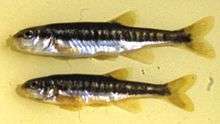Phoxinus apollonicus

| Phoxinus apollonicus | |
|---|---|
| Scientific classification | |
| Kingdom: | Animalia |
| Phylum: | Chordata |
| Class: | Actinopterygii |
| Order: | Cypriniformes |
| Family: | Cyprinidae |
| Genus: | Phoxinus |
| Species: | P. apollonicus |
| Binomial name | |
| Phoxinus apollonicus Bianco & De Bonis, 2015 | |
Phoxinus apollonicus Bianco & De Bonis, 2015, is a small cold-water adapted cyprinid fish living in the tout region of rivers of Montenegro and Albania.
Description
Unequivocally distinguished from all others Phoxinus species by the reduced number of teeth on pharyngeal bones. The species usually has four teeth on external row, but also 3 or 2, and 1 or 0 in the inner row. Others characters which, combined, can help to distinguish this species from the others: adult males has patches of breast scales connected anteriorly; the lateral line is nearly completed, posteriorly reaching the vertical line crossing the upper and the lower insertion of the caudal fin; flank of body with a marked mid-lateral longitudinal stripe extending from tip of snout to the base of caudal fin; a distinct spot at base of the caudal fin; a marked black spot on the opercular bone; the lateral line is nearly complete, the pored section include about 58-64 scales, while there are overall about 71 to 79 scales in longitudinal series. 24-26 circumpeduncular scales; 11.5-13.5 above and 10.5-12.5 below the lateral line. Dorsal fin with three simple rays followed by 7 branched rays (rarely 8). Anal fin with constantly three simple rays followed by 7 branched rays. Pelvic fins with one simple followed constantly by 7 branched rays; free margin of dorsalfin from straight to slightly convex; free margin of anal fin from straight to slightly concave. Eye roundish, iris whitish. Gill rakers on the firstgill arch, left side, are incipient o very reducedwith 5-7 total gill rakers.
Colour pattern.
In preserved specimens all fins are whitish with few scattered melanophores; peritoneum silvery with few scattered melanophores; in living specimens from Moraca-Zeta river system, Montenegro, the longitudinal band is masked by very marked and extensive vertical blotches, which, clearly, accompany one or two myomere of the trunk and of the caudal peduncle. All fins are golden yellow; the belly and the lower part of head and the body is brilliant silvery.
Distribution
River Moraca and its tributary Zeta, both belonging to the transbundary Lake Skadar drainage. Possibly P. apollonicus represents the endemic species of the Albanian ichthyogeographic district.
Derivatio nominis
From Apollonia, an ancient name to delimitate Albania.
Reference [1]
References
- ↑ Bianco, Pier Giorgio; De Bonis, Salvatore (2015). A taxonomic study on the genus Phoxinus(Acthinopterigy, Cyprinidae) from Italy and western Balkans with description of four new species: P. ketmaieri, P. karsticus, P. apollonicus and P. likai (Bianco P.G. e de Filippo G., eds.). Res.Wildl.Conserv. 4. ed.). USA: IGF. p. 22. ISBN 978-1-326-47086-9.